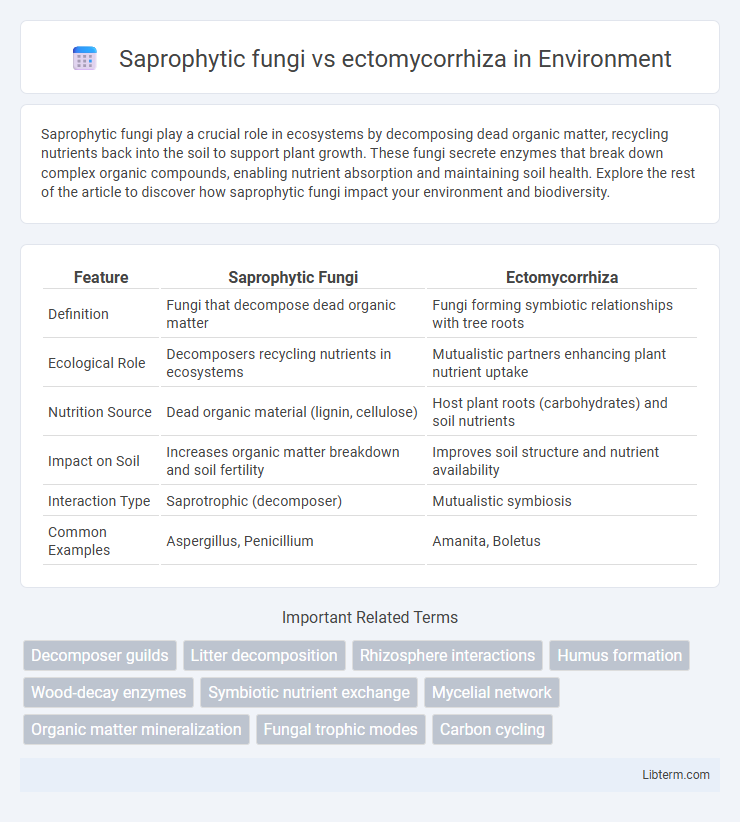Saprophytic fungi play a crucial role in ecosystems by decomposing dead organic matter, recycling nutrients back into the soil to support plant growth. These fungi secrete enzymes that break down complex organic compounds, enabling nutrient absorption and maintaining soil health. Explore the rest of the article to discover how saprophytic fungi impact your environment and biodiversity.
Table of Comparison
| Feature | Saprophytic Fungi | Ectomycorrhiza |
|---|---|---|
| Definition | Fungi that decompose dead organic matter | Fungi forming symbiotic relationships with tree roots |
| Ecological Role | Decomposers recycling nutrients in ecosystems | Mutualistic partners enhancing plant nutrient uptake |
| Nutrition Source | Dead organic material (lignin, cellulose) | Host plant roots (carbohydrates) and soil nutrients |
| Impact on Soil | Increases organic matter breakdown and soil fertility | Improves soil structure and nutrient availability |
| Interaction Type | Saprotrophic (decomposer) | Mutualistic symbiosis |
| Common Examples | Aspergillus, Penicillium | Amanita, Boletus |
Introduction to Saprophytic Fungi and Ectomycorrhiza
Saprophytic fungi obtain nutrients by decomposing dead organic matter, playing a crucial role in nutrient cycling and soil health through the breakdown of complex plant materials like lignin and cellulose. Ectomycorrhiza form symbiotic associations with the roots of many tree species, enhancing water and nutrient absorption, particularly phosphorus and nitrogen, in exchange for carbohydrates from the host plant. These two fungal types represent essential components of forest ecosystems, with saprophytes driving decomposition processes and ectomycorrhizal fungi facilitating nutrient exchange and promoting plant growth.
Key Differences Between Saprophytic Fungi and Ectomycorrhiza
Saprophytic fungi obtain nutrients by decomposing dead organic matter, playing a crucial role in nutrient cycling and soil health, while ectomycorrhiza form mutualistic associations with plant roots, enhancing water and nutrient absorption. Saprophytic fungi typically inhabit decaying wood, leaf litter, and soil, whereas ectomycorrhizal fungi colonize living root tissues, creating a symbiotic exchange of carbon for minerals like phosphorus and nitrogen. The distinct ecological functions and host interactions differentiate saprophytic fungi from ectomycorrhiza in terrestrial ecosystems.
Ecological Roles of Saprophytic Fungi
Saprophytic fungi play a crucial ecological role by decomposing dead organic matter, recycling nutrients such as carbon, nitrogen, and phosphorus back into the soil, which supports plant growth and maintains ecosystem productivity. Unlike ectomycorrhizal fungi that form mutualistic relationships with plant roots to enhance nutrient uptake, saprophytes break down complex organic compounds like lignin and cellulose, facilitating the carbon cycle and soil formation. Their activity accelerates the decomposition process, improving soil structure and fertility essential for sustaining diverse terrestrial ecosystems.
Ecological Roles of Ectomycorrhiza
Ectomycorrhizal fungi form mutualistic associations with plant roots, enhancing nutrient uptake, particularly nitrogen and phosphorus, which improves plant growth and soil health. Unlike saprophytic fungi that decompose organic matter to recycle nutrients, ectomycorrhizae facilitate nutrient exchange between soil and plants, promoting forest ecosystem stability and productivity. Their role in protecting plants from pathogens and abiotic stress also contributes to ecosystem resilience and biodiversity.
Nutrient Cycling: Saprophytes vs Ectomycorrhizal Fungi
Saprophytic fungi play a crucial role in nutrient cycling by decomposing dead organic matter, releasing essential nutrients like nitrogen and phosphorus back into the soil. Ectomycorrhizal fungi form symbiotic relationships with plant roots, enhancing nutrient uptake--particularly nitrogen and phosphorus--while facilitating carbon exchange between plants and soil microbes. The contrasting nutrient cycling functions highlight saprophytes' role in organic matter breakdown versus ectomycorrhizal fungi's involvement in nutrient acquisition and soil ecosystem stability.
Mechanisms of Decomposition and Symbiosis
Saprophytic fungi decompose organic matter by secreting extracellular enzymes like cellulases and ligninases, breaking down dead plant material to release nutrients into the soil. Ectomycorrhizal fungi form symbiotic relationships with plant roots, exchanging fungal-delivered nutrients such as nitrogen and phosphorus for carbohydrates produced by the host plant through photosynthesis. While saprophytes primarily rely on enzymatic degradation of organic substrates to obtain nutrients, ectomycorrhizae integrate nutrient uptake with living plants, enhancing nutrient cycling and soil fertility through mutualistic interactions.
Morphological Characteristics: Saprophytes vs Ectomycorrhiza
Saprophytic fungi exhibit simple, often filamentous hyphae that decompose dead organic matter, lacking specialized structures for plant root association. In contrast, ectomycorrhizal fungi form complex, branched hyphal networks called a Hartig net around plant root cells, facilitating nutrient exchange between soil and host plants. The ectomycorrhizal morphology includes a dense fungal mantle enveloping the root tips, distinguishing it from the saprophytic fungi's loose mycelial growth.
Environmental Impact and Ecosystem Services
Saprophytic fungi play a crucial role in decomposing organic matter, recycling nutrients, and enhancing soil fertility, which supports ecosystem productivity and carbon cycling. Ectomycorrhizal fungi form mutualistic associations with plant roots, improving water and nutrient uptake, enhancing plant resistance to stress, and contributing to forest health and carbon sequestration. Together, these fungi maintain biodiversity, regulate nutrient dynamics, and sustain ecosystem services essential for environmental stability and climate regulation.
Practical Applications in Agriculture and Forestry
Saprophytic fungi decompose organic matter, enhancing soil fertility and nutrient cycling crucial for sustainable agriculture by breaking down crop residues and improving soil structure. Ectomycorrhiza form symbiotic relationships with tree roots, increasing nutrient and water uptake, boosting tree growth, and enhancing resilience against pathogens in forestry. Integrating saprophytic fungi and ectomycorrhizal inoculants in land management practices promotes sustainable crop yields and forest productivity through improved soil health and plant nutrient acquisition.
Conclusion: Comparative Importance in Ecosystem Functioning
Saprophytic fungi play a crucial role in decomposing organic matter, recycling nutrients, and maintaining soil health, while ectomycorrhizal fungi enhance plant nutrient uptake and improve forest ecosystem productivity. Both fungi types are indispensable for ecosystem functioning, with saprophytes driving decomposition processes and ectomycorrhizal fungi facilitating symbiotic nutrient exchange with plants. Their complementary roles support biodiversity, soil fertility, and ecosystem resilience across various habitats.
Saprophytic fungi Infographic

 libterm.com
libterm.com